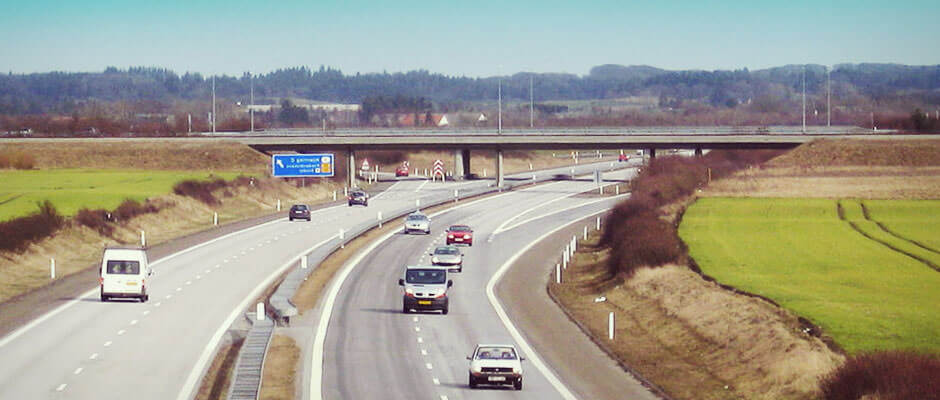Despite motorways being statistically the safest roads to drive on, they are high-speed, high-pressure environments, where you need to react quickly. This article explains what to do if you are in an accident or you witness one on the motorway.
If you have an accident on the motorway
If you can, switch on your hazard warning lights to warn other drivers. Don’t try and leave the motorway as someone involved may be injured and your car may not be safe to drive.¹
If there are any injuries, call the emergency services straight away, or try and ask someone else to. The best way to do this is via a motorway SOS phone, as the operator will know your exact location.²
This is what an emergency telephone looks like:

© Ian Britton via FreeFoto
Anyone who is not injured should try to move away from their vehicle to a safe place, ideally away from the road and hard shoulder.³ However, do not put yourself or other drivers in any danger.
Don’t leave the scene until
- The emergency services have arrived (if they were called)
- You and any other drivers involved have exchanged the following details: name, phone number, address, insurance company and vehicle details
- You have the details of any witnesses
- You are sure the car is safe to drive. Bear in mind there might be damage to your car that’s not immediately obvious
If your car is not safe to drive, we would suggest you arrange for your car to be recovered. If you’re insured with insurethebox and we haven’t called you already, call us on 0333 103 0030 from a safe place and we’ll talk you through the steps.
Please read our ‘What to do if you have an accident’ guide for general accident advice.

If you witness an accident on the motorway
Do not slow down unnecessarily, such as if the incident is on the other side of the motorway.⁴
If you decide to stop to give assistance, the Highway Code recommends the following steps:
- [symple_highlight color=”red”]First and foremost, do not put yourself in danger.[/symple_highlight]
- Turn on your hazard warning lights to warn other vehicles
- Try to use a motorway SOS phone, as this gives your exact location. If you can’t see one nearby, call 999 from your mobile.
- Give the operator as much information as you can – how many vehicles were involved in the accident? Are any injuries likely, and if so how serious do you think they will be?
- If you have called from your mobile, also give the following – what motorway are you on? Which was the last junction number you passed? Are you travelling northbound or southbound? What does the nearest marker post say?
- Anyone who is not injured should, if it’s safe, move away from the road and hard shoulder.
- If you can see someone is injured, only approach the scene of the accident if you are absolutely sure it’s safe to do so.
- Don’t move injured people from their vehicle unless they are in immediate danger.
- If you are first aid trained you may want to give assistance; if not, it sometimes helps just to offer reassurance to the injured party.
- Stay at the scene until the emergency services arrive.
If the police don’t take a witness testimony from you but you think you have information that could be useful, just call 101 and explain what happened.
We strongly recommend you download Learn2Live’s P.A.N.I.C app. It’s free, and it tells you exactly what to do in a roadside emergency. Best of all, the My Location feature gives you a grid reference for your exact location, so you can give this to the emergency services to help them reach the scene of an accident as quickly as possible.
Helping someone who’s been injured in a road accident: dos and don’ts
This is the advice given in the Highway Code. We recommend you read the full guidance here.
- Try to make the casualty as warm and comfortable as you can
- Give confident reassurance
- Stay with the casualty until the emergency service arrive (as long as you’re not putting yourself in danger)
- Remember the casualty might be suffering from shock
- Move the casualty unless you think there is a serious threat of danger
- Remove a motorcyclist’s helmet unless it’s essential
- Give the casualty any food or drink
- Leave the casualty alone or let them walk into the path of traffic
Items to keep in your car in case of emergency
You can’t predict when you might have an incident on the motorway, but you can make sure you’re slightly more prepared by having the following items in your car:
- Reflective jacket
- Torch and batteries
- Blanket
- Some warm and waterproof clothing
- Some snacks to keep your energy levels up
- A bottle of water
- The details of your insurance and breakdown (if relevant) companies
For more information on motorway incidents, see rule 275 of the Highway Code.
Source:
[1] [2] [3] [4] https://www.gov.uk/breakdowns-and-incidents-274-to-287/incidents-281-to-283Main image © Tomasz Sienicki. Licensed under CC BY 3.0 via Wikimedia Commons
Second motorway image: Smart motorways from Department for Transport under the Creative Commons Attribution-Noncommercial-No Derivative Works 2.0 Generic license.
